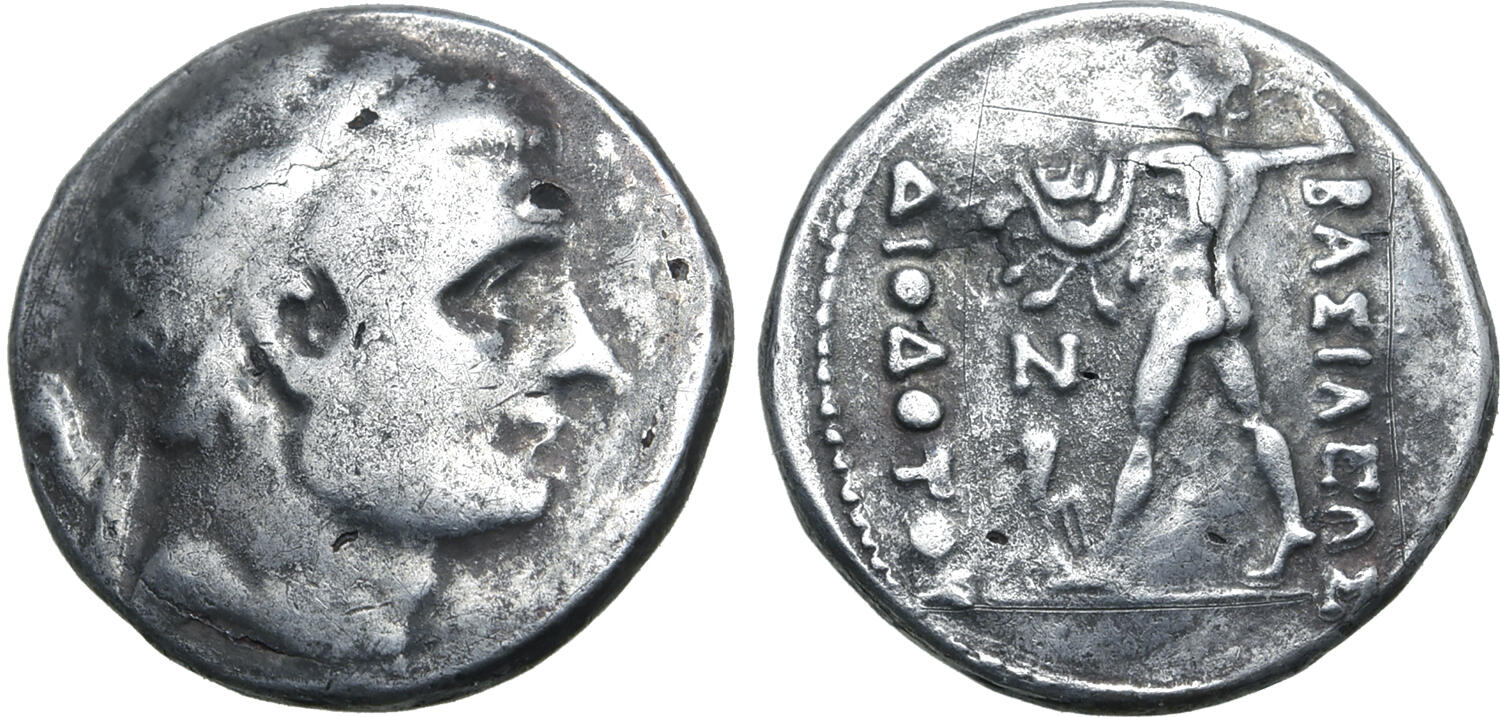S 855 - Bactria (uncertain mint) (Diodotus II), silver, drachms (235-220 BCE) Bordeaux
From SILVER
235 BCE - 220 BCE Silver 2,019 kg
Description
| ObverseInscription or printing placed on the obverse.: | Head of king Diodotus right, wearing diadem. Border of dots. |
| ReverseInscription or printing placed on the reverse.: | ΒΑΣΙΛΕΩΣ ΔΙΟΔΟΤΟΥ (Greek).Zeus left, naked, aegis on left arm, brandishing thunderbolt. At feet, eagle. In field, a monogram (and a letter). All within border of dots. |
Mint and issuing power
| MintIdentifies the place of manufacture or issue of a numismatic object.: | Bactria (uncertain mint) | Ancient regionAncient region.: | Bactria | Modern countryModern country: Afghanistan | AuthorityIdentifies the issuing power. The authority can be "pretended" when the name or the portrait of X is on the coin but he/she was not the issuing power. It can also be "uncertain" when there is no mention of X on the coin but he/she was the issuing power according to the historical sources: | Bactrian Kingdom, Diodotus II of Bactria (king in Bactria, 239-223 C) |
Chronology
| FromIdentifies the initial date in a range assigned in a numismatic context. | 235 BCE | toIdentifies the final date in a range assigned in a numismatic context.. | 220 BCE | PeriodTime period of the numismatic object.: Hellenistic 323-30 BC |
Physical description
| MetalThe physical material (usually metal) from which an object is made.: | Silver |
Median weightMedian of the weights of numismatic objects (in grams). in grams | 4.20 | DenominationTerm indicating the value of a numismatic object. Examples: tetradrachm, chalkous, denarius.: | drachma |
StandardStandard.: | Attic |
Image

S855 Diodotus II drachms.jpg [1]
References
| Die study referencePublication of the study: | Bordeaux 20181Bordeaux 2018, p. 168-170, n° 468, 472-478, 503-505, 518-521 | ||
| Coin series referenceReference to coin series study: | Sear II2Sear II, n° 7508, HGC 123HGC 12, n° 24 | ||
Obverse dies distribution
Reverse dies distribution
no distribution is available
Quantification
| Number of obversesNumber of obverse dies. ᵖ (o) | 10 | Number of singletons (o1)The number of singleton coins. ᵖ | 6 |
| Number of reverse diesNumber of reverse dies. (r) | 11 | Number of coinsNumber of coins. (n) | 15 |
| Coins per obverse dieNumber of coins per obverse die. (n/o) | 1.5 | Coins per reverse dieNumber of coins per reverse die. (n/r) | 1.36 |
| Reverse per obverse ratioRatio of obverse dies divided by reverse dies. (r/o) | 1.1 | Percentage of singletons (o1)number of coins (n) divided by the number of singletons (o1) ᵖ | 60 % |
| Original number of dies (O) (Carter 1983 formula)The estimation of the number of coins according to Carter 1983 ᵖ | 24.04 | Coins struck if 20,000 as average productivity per dieCoins made if the average productivity for obverses (according to Carter) is 20,000. ᵖ | 480,800 |
| Original number of dies (O) (Esty 2011 formula)The estimation of the number of coins according to the singleton formula in Esty 2011 ᵖ (O) | 30 | Survival rate if 20,000 as average productivity per dieSurvival rate if average productivity is 20,000. ᵖ | 0.00003 |
| Coverage (o = % of O) (Esty 1984 formula)Esty 1984 - coverage (% of O) ᵖ (o = % of O) | 60% | Die productivity if survival rate 1/2,000Average productivity if survival rate is 1/2,000. ᵖ | 1,247.92 |
| Weight of silver (in kg) if 20,000 coins per die (O = Carter formula)Carter 1983 * Median weight * 20000 (*10 if gold or electrum) ᵖ | 2,019 kg <br /> 2,019 kg | Die productivity if survival rate 1/5,000Average productivity if survival rate is 1/5,000. ᵖ | 3,119.8 |
Remarks
References
- ^ Bordeaux, Olivier (2018), s (IIIe s. a.C.-Ier s. p.C.), Numismatica Antiqua 8, Bordeaux, 326 p.
- ^ Sear, David R. (1979), Greek coins and their values. Vol. II, Asia and North Africa, London, xlviii, p. 317-762
- ^ Hoover, Oliver D. (2013), Handbook of coins of Baktria and ancient India : including Sogdiana, Margiana, Areia, and the Indo-Greek, Indo-Skythian, and native Indian states south of the Hindu Kush, fifth century BC to first century, Lancaster-London,